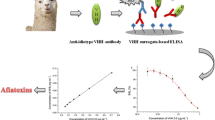Abstract
Horseradish peroxidase (HRPO) was used as a probe to quantitate aflatoxin B1 by a homogeneous immunoassay. The conjugation of AFB1 to HRPO resulted in 54% loss of enyzme activity. In the presence of AFB1 specific antibodies, the HRPO-AFB1 conjugate showed reversal of its lost enzyme activity by 12%. This positive modulatory effect of antibody on the enzyme activity was used as an analytical tool to quantitate AFB1. The homogeneous assay carried out with free AFB1 and HRPO-AFB1 conjugate in the presence of antibodies indicated poor linearity as compared to the heterogeneous assay. It was observed that the number of HRPO-lysine residues involved in AFB1 conjugation were 6–8. The low level of modulation of enzyme activity by antibody with respect to HRPO-AFB1 conjugate, could possibly be attributed to the limited number of lysine residues in the HRPO molecule and its proximity to the active site of the enzyme. Thus, HRPO was found to be limiting as an enzyme with respect to the homogeneous enzyme immunoassay for AFB1 analysis. The antibodies raised were specific for AFB1, and showed excellent linearity even at high dilution for the detection of AFB1 by ELISA indicating that antibodies per se were not the limiting factor.
Similar content being viewed by others
References
Anonymous (1988) Mycotoxins 1987: Report on the Second Joint FAO/WHO/UNEP. International Conference on Mycotoxins, Bangkok, Thailand. Food and Agriculture Organisation, Rome
Lee LS (1989) J Am Oil Chem Soc 66:1398–1413
Ellis WO, Smith JP, Simpson BK (1991). CRC Crit Rev Food Sci Nutr 30:403–439
Pohland A (1993) Food Addit Contam 10:17–28
Van Egmond HP (1988) Food Addit Contam 6:139–188
Pestka JJ (1988) J Assoc Off Anal Chem 71:1075–1081
Anonymous (1990) Manuals of food quality control-10. Training in mycotoxin analysis. Food and nutrition paper 14/10. Food and Agriculture Organisation, Rome, pp 4–44
Chu FS (1992) Development and use of immunoassays in the detection of ecologically important mycotoxins. In: Bhatnagar D, Lillehoj EB, Arora DK (eds) Handbook of applied mycology, vol 5. Dekker, New York, pp 87–136
Scott PM (1993) Trends Anal Chem 12:373–381
Keoltzow DE, Tanner SN (1990) J Assoc Off Anal Chem 73:584–589
Langone JJ, Van Vunakis H (1976) J Natl Cancer Inst 56:591–595
Erlanger BF, Beiser SM, Borek F, Edel F, Lieberman S (1967) Preparation of antigen and antibodies. In: Methods in immunology and immunochemistry, vol 1. Academic Press, New York London, p 144
Sashidhar RB, Narasinga Rao BS (1988) Indian J Exp Biol 26:984–989
Ouchterlony O, Nilsson LA (1986) Immunodiffusion and immunoelectrophoresis. In: Weir DM, Herzenberg LA, Blackwell C (eds) Handbook of experimental immunology, vol I. Blackwell, Oxford, pp 32.1–32.5
Harlow E, Lane D (1988) In: Antibodies. Cold Spring Harbor Laboratory, New York, pp 298–302
Tijssen P (1985) Practice and theory of enzyme immunoassays. In: Burdon RH, Van Knippenberg (eds) Laboratory techniques in biochemistry and molecular biology, vol 15. Elsevier, Amsterdam, p 279
Erlanger BF (1980) The preparation of antigenic hapten carrier conjugates: A survey. In: Van Vunakis H, Langone JJ (eds) Methods in enzymology, vol. 70. Academic Press, New York, pp 85–104
Sashidhar RB, Capoor AK, Ramana D (1994) J Immunol Methods 167:121–127
Rubenstein KE, Schneider RS, Ullman EF (1972) Biochem Biophys Res Commun 47:846–851
Bastiani BJ (1979) Antibiot Chemother 26:89–97
Ngo TT, Lenhoff HM (eds) (1985) In: Enzyme-mediated immunoassay. Plenum Press, New York, pp 1–57
Maehly AC (1955) Plant peroxidases. In: Colowick SP, Kaplan NO (eds) Methods in enzymology, vol II. Academic Press, New York, p 807
Worthington C (ed) (1988) In: Worthington enzyme manual. Worthington Biochemical Corporation. New Jersey, p 254
Author information
Authors and Affiliations
Rights and permissions
About this article
Cite this article
Ramana, D., Capoor, A.K., Sashidhar, R.B. et al. Limitations in the use of horseradish peroxidase as an enyzme probe in the development of a homogeneous immunoassay for aflatoxin B1 . Fresenius J Anal Chem 352, 43–48 (1995). https://doi.org/10.1007/BF00322294
Received:
Accepted:
Issue Date:
DOI: https://doi.org/10.1007/BF00322294




